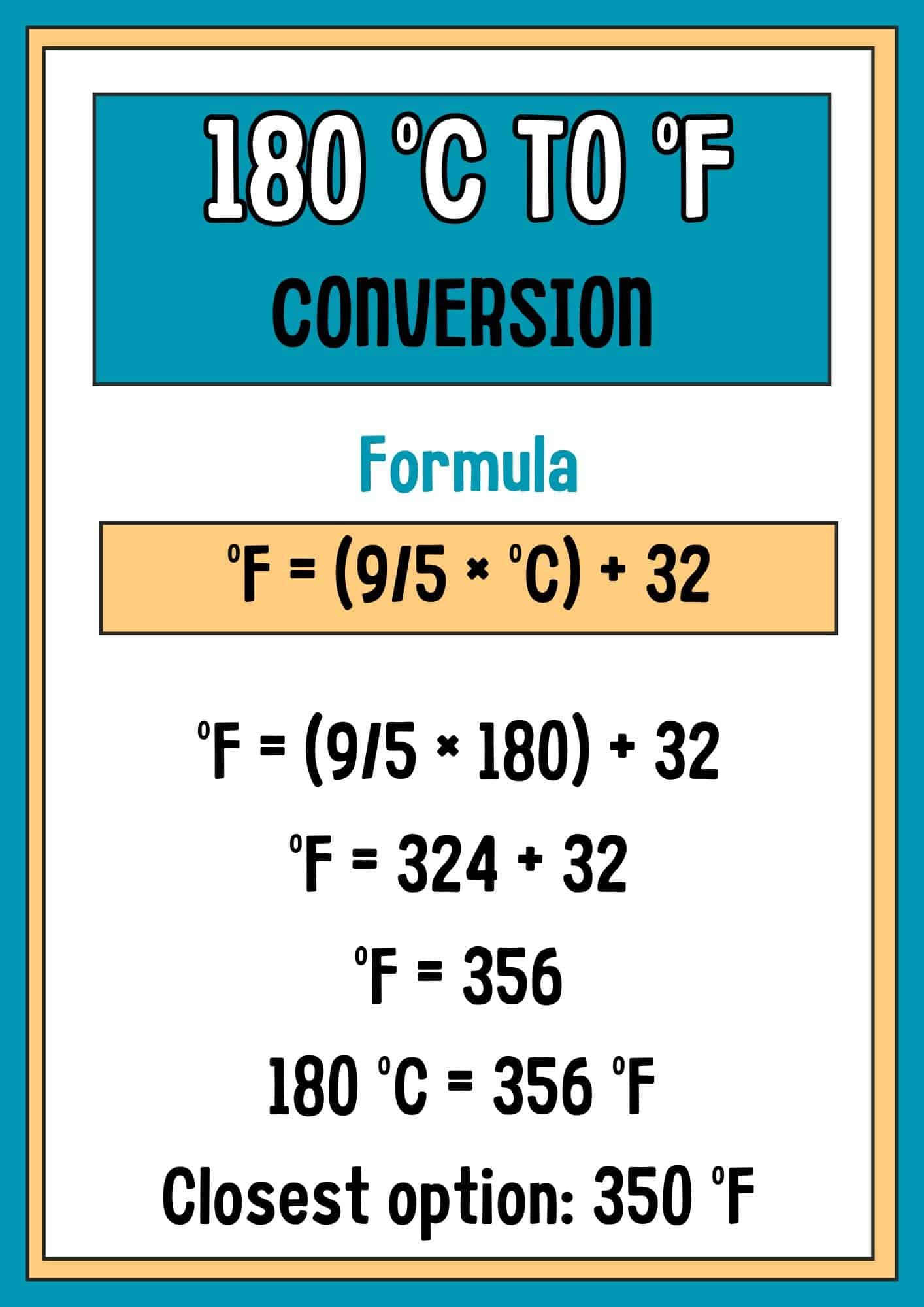Understanding temperature conversions is essential in various aspects of life, from cooking and baking to understanding weather forecasts while traveling. If you’ve ever wondered, “What Is 180 Degrees Celsius In Fahrenheit?”, you’re in the right place. 180 degrees Celsius (180°C) is equal to 356 degrees Fahrenheit (356°F). This article will delve into the conversion process, its practical applications, and provide helpful tables for quick reference.
The Simple Formula for Celsius to Fahrenheit Conversion
Converting Celsius to Fahrenheit is straightforward with a simple formula. This formula allows you to convert any temperature from Celsius (°C) to Fahrenheit (°F) accurately. The formula involves multiplying the Celsius temperature by a factor and then adding a constant value.
Here’s the formula:
°F = (°C × 9/5) + 32
Alternatively, you can use the decimal equivalent of 9/5, which is 1.8. The formula then becomes:
°F = (°C × 1.8) + 32
Where:
- °F represents the temperature in Fahrenheit.
- °C represents the temperature in Celsius.
This formula works because the Fahrenheit scale is defined differently from the Celsius scale. The Fahrenheit scale sets the freezing point of water at 32°F and the boiling point at 212°F, a 180-degree difference. The Celsius scale, on the other hand, sets freezing at 0°C and boiling at 100°C, a 100-degree difference. This difference in scale and zero points necessitates the conversion formula.
Step-by-Step Calculation: Converting 180°C to Fahrenheit
Let’s apply the formula to convert 180 degrees Celsius to Fahrenheit:
- Identify the Celsius temperature: In this case, it’s 180°C.
- Multiply by 9/5 (or 1.8): 180 × (9/5) = 180 × 1.8 = 324
- Add 32 to the result: 324 + 32 = 356
Therefore, 180°C = 356°F.
This calculation confirms that 180 degrees Celsius is precisely 356 degrees Fahrenheit.
180°C to Fahrenheit in Oven Temperatures: Practical Cooking Conversions
While the exact conversion of 180°C is 356°F, oven temperatures are often rounded to the nearest common setting for practical cooking. Most ovens don’t offer the precision of setting a temperature to 356°F. In cooking, slight variations in temperature are usually acceptable, and recipes are designed to be forgiving within a small range.
For oven settings, 356°F is typically rounded down to 350°F. Therefore, when a recipe calls for 180°C oven temperature, you would generally set your oven to 350°F.
For practical oven settings:
180°C ≈ 350°F
This slight adjustment is negligible in most baking and cooking scenarios and simplifies oven temperature settings.
 Oven Temperature Conversion 180C to 350F
Oven Temperature Conversion 180C to 350F
Comprehensive Celsius to Fahrenheit Conversion Table
For quick reference, here’s a more extensive table converting common Celsius temperatures to Fahrenheit. This table includes temperatures around 180°C and beyond, useful for various applications.
| Celsius (°C) | Fahrenheit (°F) |
|---|---|
| 0°C | 32°F |
| 50°C | 122°F |
| 100°C | 212°F |
| 150°C | 302°F |
| 160°C | 320°F |
| 170°C | 338°F |
| 180°C | 356°F |
| 190°C | 374°F |
| 200°C | 392°F |
| 210°C | 410°F |
| 220°C | 428°F |
| 230°C | 446°F |
| 240°C | 464°F |
| 250°C | 482°F |
| 300°C | 572°F |
Oven Temperature Conversion Table (Rounded Values)
When cooking or baking, using rounded Fahrenheit values for common Celsius oven settings is practical. Here’s a table with rounded Fahrenheit temperatures for typical oven settings:
| Celsius (°C) | Fahrenheit (°F) (Rounded) | Common Oven Setting |
|---|---|---|
| 140°C | 275°F | Warm |
| 150°C | 300°F | Very Slow |
| 160°C | 325°F | Slow |
| 180°C | 350°F | Moderate |
| 190°C | 375°F | Moderate to Hot |
| 200°C | 400°F | Hot |
| 220°C | 425°F | Hot |
| 230°C | 450°F | Very Hot |
| 240°C | 475°F | Very Hot |
| 250°C | 500°F | Extremely Hot |
Why is Celsius and Fahrenheit Used? A Brief Overview
The Celsius and Fahrenheit scales are the two most common temperature scales used worldwide, each with its own history and areas of prevalence.
- Celsius: Part of the metric system, Celsius is used in most countries worldwide for everyday temperature measurements, including weather forecasts and cooking. It’s based on the properties of water, making it scientifically intuitive.
- Fahrenheit: Primarily used in the United States and a few other territories, Fahrenheit was historically more widespread. While less scientifically intuitive than Celsius, it’s still deeply ingrained in everyday usage in these regions.
Understanding both scales and knowing how to convert between them is increasingly useful in our globalized world.
Practical Applications of Celsius to Fahrenheit Conversion
Knowing how to convert Celsius to Fahrenheit has numerous practical applications in daily life:
- Cooking and Baking: Recipes from different parts of the world might use Celsius or Fahrenheit. Converting temperatures ensures your dishes are cooked at the correct temperature, whether you are following a European recipe in Fahrenheit-based oven or vice versa. For example, knowing that 180°C is about 350°F is crucial for accurately baking goods.
- Travel: When traveling internationally, you’ll encounter temperature scales that may be unfamiliar. Converting temperatures helps you understand weather forecasts, assess comfort levels, and adjust accordingly. If a weather app shows 25°C, and you’re used to Fahrenheit, quickly converting it to 77°F gives you a better sense of the warmth.
- Science and Industry: While Celsius is the standard in most scientific fields, some industries, particularly in the US, may still use Fahrenheit. Accurate conversions are vital for research, manufacturing processes, and ensuring precise temperature control in various applications.
In conclusion, understanding the conversion between 180 degrees Celsius and Fahrenheit, and more broadly, between the two scales, is a valuable skill. Whether for cooking, travel, or professional purposes, this knowledge ensures accuracy and avoids potential errors due to temperature misunderstandings. Remember, 180°C is 356°F, and for oven settings, it’s commonly rounded to 350°F for ease of use.